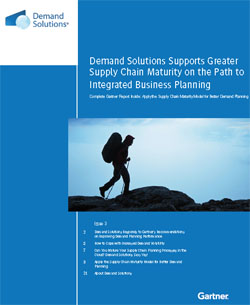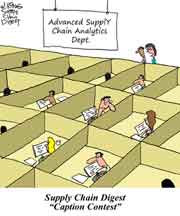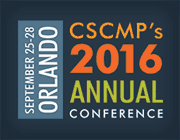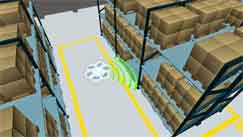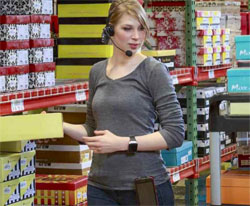 |
October 13, 2016 - Supply Chain Flagship Newsletter |
 |
| FEATURED SPONSOR: APEX SUPPLY CHAIN TECHNOLOGIES |
|||
 |
|||
| Find out more About ACTYLUS™ Smart Bins with Automated Restock Alerts that keep VMI lines up & Running |
|||
 |
|
|||||||||||||||||||||||||||||||||||||||||||||||||||||||||||||||||||||||||||||||||||||||||||||||||||||||||
As almost always, I attended something in each of these seven slots. Last week, I reported on how Dell has taken a bold and interesting approach to developing an innovation culture to drive progress in Sustainability; how Nike is moving from a traditional linear supply chain model to a "responsive" supply chain, driven by ecommerce changes; and highlights from an interesting panel discussion on the future of warehousing, in which the insightful Steve Reade of DSW shoes noted (among other observations) that we need to break down operational silos across different process areas of the DC to look more holistically at optimizing total product flow. When I sat down this week to highlight more of the sessions, something really hit me: here just two weeks later, it is already getting hard to make sense of my notes, which seemed clear enough at the time. I will combine that with the observation that it seems all conferences, such as the MHI event in Phoenix next week, are emphasizing session content that attendees can take back and use right away, to drive perceived value. So I am combining my growing difficulty making sense of my CSCMP notes and the perceived need for ideas that conference attendees can use right away to say there needs to be a better way. First, more conferences and speakers should make conference presentations available to attendees (CSCMP does so with a modest delay if OKed by the speakers). The silliness of attendees taking pictures of slides with their phones because the slides won't be available later is a key symptom of this condition (yes of course, I am aware many companies prohibit slides from being made public - we need to work on this). Second, an even better idea: speakers and panelists should be required to submit a "Cliff notes" version of their presentations. That is in effect what I am doing here with these summaries, but just think if rather than needing to rely on madly scrambled note taking, session attendees had access to the key points in some kind of document for each session. If done well, that could make a huge difference in attendee value and satisfaction, it seems to me.
That is certainly one great idea from the conference you may be able to start using very soon. On Tuesday, Mani Janakiran of Intel gave a very interesting presentation on the company's incredible use of advanced supply chain analytics. Using a variety of tools, some home grown using general purpose analytics platforms, and others built using LLamasoft, Intel has just about completely modeled its entire supply chain at a level I believe is rare, on top of which it just keeps adding on analytic applications. That includes a "supply-demand solver" that looks out over some horizon, and not only identifies where there is a gap in S&OP plans, but also suggests how the issues might be best resolved. Another called "inventory surveillance" provides a neat visual simulation of how inventory will flow across the supply chain to customers over some period of time, and again identifies likely problem areas. The bottom line here: there is no magic bullet, many companies get by OK with rules of thumb or experience, but from a statistical approach the Croston Method (developed in the 1970s) is the best we have, though some software companies have proprietary approaches that may do better. To be honest, was looking for a little more out of this presentation. Did you go to CSCMP 2016? If not, why not? If yes, what are your thoughts? Any reaction to the educational session summaries this week? Let us know your thoughts at the Feedback section below.
|
||||||||||||||||||||||||||||||||||||||||||||||||||||||||||||||||||||||||||||||||||||||||||||||||||||||||||
|
||||||||||||||||||||||||||||||||||||||||||||||||||||||||||||||||||||||||||||||||||||||||||||||||||||||||||
|
||||||||||||||||||||||||||||||||||||||||||||||||||||||||||||||||||||||||||||||||||||||||||||||||||||||||||
|
|
|
YOUR FEEDBACK
We're just featuring this week an interesting email exchange relative to a point made by Thomas Moore of Warehouse Optimization on a recent Supply Chain Newsmakers video, which argued that shippers can have much to gain through a better understanding - load by load - of their carriers' true weight limits.
David Schneider of David K. Schneider & Company took some exception to this notion, as you can see from his email below, and then Moore's interesting response back.
Both are friends of SCDigest - and we would be happy with one more repost from Schneider!
Feedback on Knowing Carriers' True Weight Limits
![]()
The video segment brought this phrase to my mind: "Your performance will vary."
I’m not calling bull s--t on what the fellows from Warehouse Optimizers talked about, but there are practical factors that I think could be wrongly defined as "tribal" knowledge.
Fuel weighs something: Over the road diesel weighs about 7.1 pounds per gallon. So every 100 gallons of fuel on board adds 710 pounds to the GVW of the rig. Many drivers know this, and will wait to fuel until after they have scaled their load if they know that they are close to the 80K limit. Is this "tribal knowledge?" No, as it is something that is taught in many of the driver schools. While a local delivery rig may hold only 45 gallons of fuel in each side tank, it is not unusual to see rigs with 130 gallons on each side, sometimes more.
Driver and driver's gear weigh something: The driver's weight is obvious, but people tend to forget that drivers often live in their tractors - and the belongings can weigh in.
Accessories on the truck: Snow Chains, HazMat kit, skirts, Aero-tails, APU units, again, these all add weight.
Trucking companies do not have high consistency across the fleet. They may specify the same basic model, but the accessories will change the weight of the tractor and the trailer from unit to unit. Metal roof trailer or translucent plastic roof? Hardwood trailer floor or a composite material? E track or logistics track (they are different).
What is getting identified as "tribal: is really a reflection of the variability of vehicle weights based - the complexity of the fleet. If you ask a trucking dispatcher, a driver, or an executive what a truck weighs, they are going to give you the "average" because they recognize that the weight of a truck depends on many factors that are out of control.
David K. Schneider
David K Schneider & Company, LLC
Response from Moore:
This is great! It typifies the response that we often see. The Tribe has a set of assumptions that generate "safe" answers. Here is a very concrete example from companies that shall remain nameless - the total weight that refrigerated trucks can carry:
Company 1 45,000
Company 2 44,000
Company 3 43,500
Company 4 42,000
They all use about the same carrier base!
Data is the key. We took Swift's and JB Hunt's fleets and weighed the various combinations of tractors and trailer a few years back. Yes there was variation and yes we could not take the lightest tractor and the lightest trailer as our standard - but we developed a standard that 95% of the fleet could easily meet.
In another example, it turned out that JBH intermodal had a habit of sending sleepers into the client to drive the 25 miles to the ramp -the client asked them to stop doing that so they could get the extra weight on the loads. Will Cotten's example in the video is real. He ran many loads for, what turns out to be, one of our current clients!
To put this all in perspective, 8 years ago we got about 880,000 records of 5 axle trucks weighed by the DOT. Of those that were clearly weighted out (more than 69K gross) a very large number(81%) had >3000 gross weight available.
Thomas Moore![]()
SUPPLY CHAIN TRIVIA ANSWER
Q: In honor of National Manufacturing Day last Friday, about how many manufacturing workers are there in the US?
A: About 12.3 million at the end of 2015 – down about 5 million from 2000, but holding fairly steady of late. We’ll note that count generally includes white collar employees working in manufacturing plants, something rarely mentioned relative to this number.
| © SupplyChainDigest™ 2003-2016. All Rights Reserved. SupplyChainDigest PO Box 714 Springboro, Ohio 45066 |
POWERED BY: XDIMENSION
|

